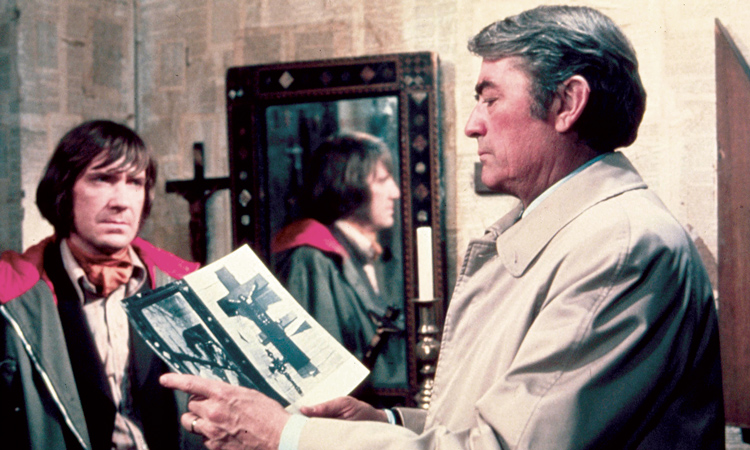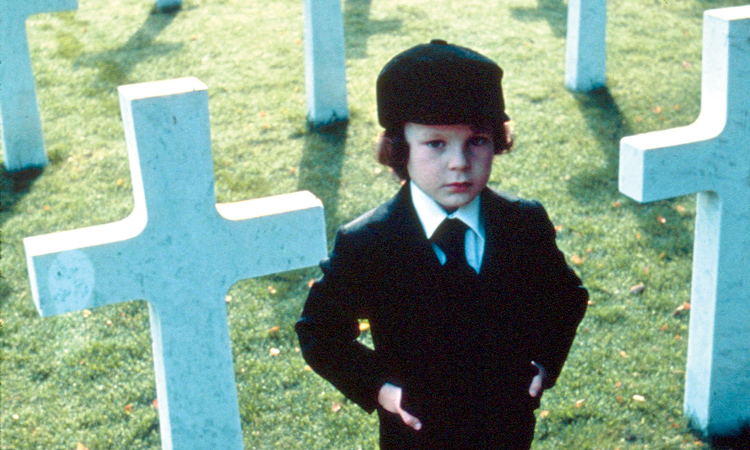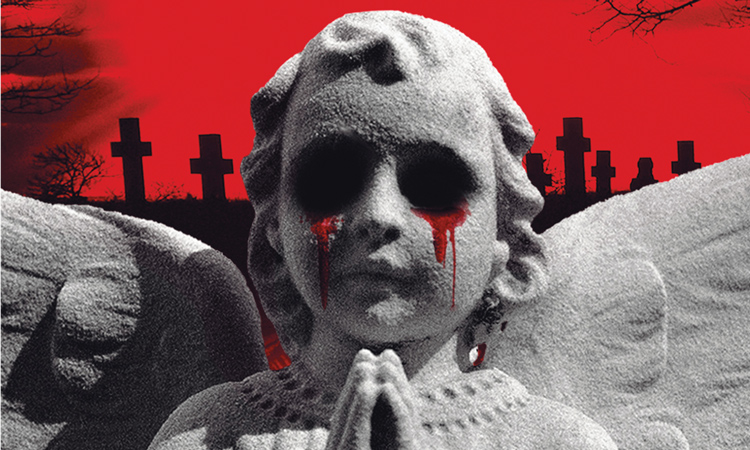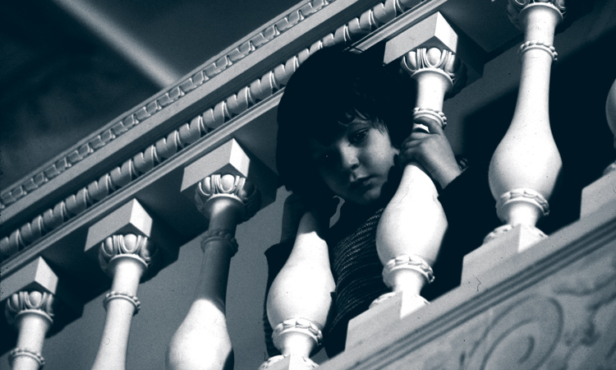“Dick said to me: ‘There must be nothing in this movie that you can’t believe is [real] – the whole force of this movie is going to be the critical mass of a man’s paranoia coming to be realised as actual,’” recalled The Omen scribe David Seltzer regarding director Richard Donner’s intentions for the 1976 horror film. Two years before convincing audiences that a man could fly with Superman, the filmmaker was attempting to achieve a level of believability out of a story where the devil murders an American diplomat’s newborn and replaces him with the offspring of a jackal… who happens to be the Antichrist.
“I wanted to treat this like a reality […] teasing out the psychological instead of the fantastical. Less on blood and gore and effects and more relying on the actors’ unique ability to convey conviction,” he remarked.
Instrumental in achieving this level of conviction was the casting of the patriarchal lead star. After Hollywood heavyweights Charlton Heston, Roy Scheider and William Holden all turned the part down, the role of Robert Thorn, the US ambassador to the UK who unknowingly makes a deal with the devil by secretly adopting a baby boy to spare his wife from the grief of a miscarriage, fell on the dependable hands of then, 60-year-old Gregory Peck. Grief-stricken from the recent loss of his son from suicide, the dignified Oscar-winning star brought credibility to the story along with a level of morbid authenticity.
There was religious legitimacy too, with Seltzer taking inspiration from The Book Of Revelations and expanding upon its apocalyptic premonition of hell on earth by asking: ‘What if the Antichrist came back as a boy?’
To embody the pivotal devil child Damien, thousands of adolescent boys were tested, until four-year-old Harvey Stephens won the part after having the audacity to punch a goading Donner in the testicles during his audition! With his blonde hair dyed dark with shoe polish and the insertion of contact lenses to change the colour of his eyes, Stephens would certainly look the demonic part too.

Cast as the Antichrist’s innocent (step) mother was Lee Remick. Her angelic features, powerless naivety and wide-eyed reaction to the ungodly circumstances that Damien provokes make her utterly relatable, as does her anguish in being unable to connect with ‘her child’. The Omen features a host of distinguished British talent too; including former Doctor Who Patrick Troughton as angst-ridden Father Brennan, who attempts to forewarn the Thorns, the ever-versatile David Warner as agnostic photographer Keith Jennings (who meets a memorable beheading) and an uncredited Leo McKern as Jerusalem-based Antichrist archaeologist Carl Bugenhagen. However, it’s Billie Whitelaw that steals the show as literal nanny from hell Mrs Baylock, who chillingly declares to young Damien: “Have no fear, little one… I am here to protect thee.”
Also helping to ground events in reality was the recognisable UK locations that embrace everything, from Great Cumberland Place and Bishop’s Park in London, to Guildford Cathedral and the subsequently decommissioned Windsor Safari Park. They serve as effective backdrops that authenticate several chilling scenes and jaw-dropping death sequences.
One such disturbing sequence is set at the aforementioned Safari Park (now Legoland Windsor) where a group of baboons become disgruntled and mount a horrific attack on the Thorn’s passing car after sensing Damien’s unholy presence. To achieve the fierce reaction from the usually docile park primates, Donner baited the baboons by nursing an injured Alpha male from the backseat of the car. Regrettably, a zoo lion killed a park guard following the filming of another scene after fatally neglecting to close his booth. This was just one example of the so-called ‘Omen curse’ that plagued production seeming to signify that the devil didn’t want the movie made.
With the film originally titled ‘The Birthmark’, Seltzer came up with his own creative way to identify the devil child, with the infamous numbers 666 associated as the unholy sign of the beast. It was a complete fabrication, that’s not referenced in The Book Of Revelations. However, the devil is in the detail and the scene where Robert Thorn discovers that Damien is the Antichrist after locating the birthmark on his scalp remains goosebump-inducing, even if its effect has become somewhat diluted thanks to being famously lampooned in sitcoms likes Only Fools And Horses and South Park.
Nevertheless, the discovery leads to one of the most powerful denouements in cinematic horror history, when Thorn, grappling with guilt over the deception that has now led to the death of his beloved wife, attempts to assassinate Damien at the altar of a church (with one of the sacred Seven Daggers of Megiddo), but is shot dead by police. The film would’ve ended with the death of Damien too if it wasn’t for 20th Century Fox studio head Alan Ladd Jr. intervening. “There would’ve been a third coffin, which was the little boy’s, but when he saw it he said: ‘Dick, I just want to ask you one thing: can you keep the kid alive?’” reflects Richard Donner on the DVD commentary. As a result, the funeral sequence was reshot to include the chilling twist that Damien survived the ordeal and has eloped with the President of the United States.
Marketing got devilishly creative selling the film – slyly anticipating the apocalyptic consequences by counting down the days till The Omen’s inauspicious 6 June 1976 UK release and teasing: ‘You are one day closer to the end of the world.’ The box office certainly wasn’t jinxed however, and The Omen went on to become a massive commercial hit that revived the previously floundering Fox Studios, the success of which helped secure funds for George Lucas to finish the first instalment of a certain intergalactic space opera. Incidentally, The Omen’s director-of-photography Gilbert Taylor went on to lens Star Wars, while Jerry Goldsmith’s iconic score for The Omen, which features a creepy piano motif along with scary religious hymns based on Gregorian chants, would win a deserved Oscar.

With this almighty success, the franchise potential of The Omen was soon realised and a staggering seven films was originally envisioned, that were ultimately reduced down to a manageable trilogy.
Set seven years after the original, with a story penned by series producer Harvey Bernhard, 1978’s Damien: Omen II centred on a more emotionally developed 12-year-old incarnation of the character (played by Jonathan Scott-Taylor), who is now able to articulate his thoughts as he learns the terrifying truth of his ancestry.
As Richard Donner was busy directing Superman, Fox originally appointed the British auteur (and future Flash Gordon filmmaker) Mike Hodges to helm the now Chicago-set coming-of-age story. However, his apparent sluggish direction and alleged uncompromising nature infuriated Bernhard who replaced him with American filmmaker Don Taylor a mere three-weeks into production. “Mike Hodges […] didn’t see the picture the way I saw the picture, and it was unfortunate, but Don Taylor was great, and he was a great pal of mine,” reflected the late producer on the 2000-recorded DVD commentary track.
The sequel assembled another eclectic cast of this time predominantly American talent. Playing Damien’s latest guardian, industrialist Richard Thorn, brother of Robert from The Omen, was esteemed actor William Holden, (who had ironically turned the lead down in the original) while recent-Oscar winner Lee Grant portrayed Damien’s new stepmother and Thirties screen star Sylvia Sidney features as hardened Aunt Marion, who isn’t afraid at voicing her suspicions about the troublesome teen. Lance Henriksen played Sergeant Neff, who takes the adolescent under his wing during his training at a military academy and instrumentally reveals to him his satanic lineage.
Despite arguably retracing the narrative steps of its superior predecessor, without really furthering the story, and playing out like a series of ever more gruesome death sequences, Damien: Omen II remains a fun, thrilling and watchable entry in the series. Bernhard nevertheless lamented what could have been. “I always felt that we should have made it at high school [because] what the hell are you going to do with a 13-year-old kid? At high school he could be effective. I think it would’ve been a better picture…” he concluded.
1981’s presumed concluding chapter, Omen III: The Final Conflict, would significantly advance events to embrace a now mature, 33-year-old Damien who has acquired the position of international conglomerate CEO of his late adopted father’s Thorn Industries (which controls the world’s food supply). Fulfilling the prophecy that the devil’s child rises in the world of politics, Damien subsequently becomes the US ambassador to Great Britain after using his ungodly powers to murder the existing one.
“It was a privilege to be offered a sequel to an established box-office hit, but this itself posed several creative and philosophical questions,” British filmmaker Graham Baker, who directed The Final Conflict, admits to SciFiNow. “The Omen trilogy takes the form of the beginning, development and resolution of a dramatic narrative, dealing with a story built around an intense, spiritual, moral, almost political conflict. My view was that [the previous films] lost much of the dramatic potential of the story by an emphasis on episodic, superfluous and gratuitous violence, where the creative ‘house style’ seemed to concentrate on how original, ingenious and grotesque the numerous deaths could appear. My aim was to produce an engaging, dramatic finale to the trilogy.”

With the perceived ‘Second Coming of Christ’ a looming threat to him, Damien has to take drastic measures to protect his perceived destiny: ordering the murder of a glut of newborns who could all be the baby Jesus. “I wanted to integrate Omen III’s share of gory deaths into the narrative rather than appear as superficial punctuation, especially in the killing of the newborn children – a particularly unpleasant sequence essential to the story, which I depicted by suggestion rather than detailed, direct ‘hands on’ action,” says Baker.
This time a young, then relatively unknown New Zealand actor by the name of Sam Neill embodied the adult Antichrist. This was over a decade before he became known internationally for protecting kids from fearsome dinosaurs in Jurassic Park. “He was recommended at a very early stage in the pre-production by James Mason, who was his mentor,” remembers Baker. “It was a relationship that clearly influenced Sam’s style; you can hear this in his slow, deliberate, faintly ironic tone of his delivery. His eyes have a certain quality that worked well in close-up to suggest the power of Damien’s will, prompting the horse to throw its rider over the viaduct in the hunt sequence, for example.”
The director also had a positive working relationship with hands-on producer Harvey Bernhard; whom he says had considerable input in Andrew Birkin’s screenplay to ensure it inherited both the story details and essential ‘house style’ from The Omen mythology. “Harvey was also very supportive, given to outbursts of enthusiasm, and our relationship was at all times productive to the point that it became as genuine a friendship as can exist in the hothouse of filming,” Baker continues. “I don’t recollect him ever being negative or resistant to my direction, although a couple of my touches were not to his taste.”
Indeed one scene, which elicited a mixed response from Bernhard, was the killing of the aforementioned US Ambassador. “Harvey was shouting with delight at the various close shots of blood and pieces of brain spattering in slow motion over the US seal on the wall behind the Ambassador’s bloody head as a bullet hits it,” recalls Baker. ‘Wow… Wow! Look at that blood! Jeez – the brains… that’s fucking great!’ […] Then came the shot of the Ambassador’s body showing his legs stretched below the desk where I had [him], in his death throes, tap a foot against the desk in a three-second spasm before becoming still. Harvey was silent. He looked at me incredulously: ‘Hey, pal… you must have had a real disturbed childhood.’”
Helping to heighten the gravitas was Jerry Goldsmith who returned to compose an epic operatic score. “Jerry’s score is one of his greatest, not just in the quality of the music itself but particularly in its narrative power as a storytelling element,” offers Baker. “I’m quite certain Jerry was influenced in his stylistic approach by the operatic feel of many of the scenes – for example, the ‘Disciples of the Watch’ night sequence, where Damien addresses the huge crowd of ecstatic followers.” Indeed, it’s a particularly powerful scene, where Damien’s role as the great deceiver and father of lies is chillingly cemented.
However, it was The Final Conflict’s denouement, shot over three nights in May at the eerily isolated ruins of Fountains Abbey in North Yorkshire that provoked genuine atmospherics. “Though we were blessed with clear skies, around midnight, as the ground temperature dropped, a mist began to rise from the river and with it a freezing band of icy air,” remembers Baker. “It really was quite surreal, with tiny figures working below the towering ruins part-lit and silhouetted by spilled light and above all the shrieking bats that flitted and swooped about […] working on an intense sequence in such conditions can create a heightened sense of dramatic awareness.”
But was there any sign of the devil’s wraith during the filming of the titular conflict? “The generator did catch fire at Fountains Abbey and I vaguely remember the camera crew, with semi-straight faces, claiming that the camera jammed while scene 666 was being slated, but while being amused by the publicity department leaping on these gifts, I remained sceptical!” assures Baker.
Despite the finality hinted in the title, a decade later another sequel surfaced; the made-for-Fox-TV-movie rehash Omen IV: The Awakening. It returned the Antichrist threat to a proposed devil child, this time a female called Delia (adopted once again by a couple with political connections) and features the twist revelation that she’s the daughter of the deceased Damien from The Final Conflict. Despite a bleak open ending, the ham-fisted direction, problematic performances and lukewarm reception put an end to any more follow-ups, until a misguided but well-meaning cinematic remake of The Omen was auspiciously released on 6 June 2006 to mark its 30th anniversary.
Since then there’s been Damien, a short-lived TV series that premiered in 2016 and featured Brit Bradley James in the title role. But it’s the original Omen trilogy that remains the celluloid benchmark for the Antichrist, going some way to disputing the Devil’s greatest trick of convincing the world that he doesn’t exist.
The Omen is available on Blu-ray and DVD from Walt Disney Studios Home Entertainment.
